| Listing 1 - 10 of 17 | << page >> |
Sort by
|
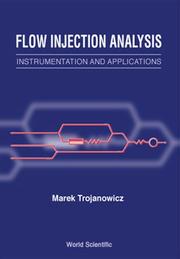
ISBN: 9812813721 9789812813725 9810227108 9789810227104 Year: 2000 Publisher: Singapore River Edge, NJ World Scientific
Abstract | Keywords | Export | Availability | Bookmark
 Loading...
Loading...Choose an application
- Reference Manager
- EndNote
- RefWorks (Direct export to RefWorks)
The concept of flow injection analysis (FIA) was introduced in the mid-seventies. It was preceded by the success of segmented flow analysis, mainly in clinical and environmental analysis. This advance, as well as the development of continuous monitors for process control and environmental monitors, ensured the success of the FIA methodology. As an exceptionally effective means of mechanization for various procedures of wet chemical analysis, the FIA methodology, in use with a whole arsenal of detection methods of modern analytical chemistry, proved to be of great interest to many.The fast and
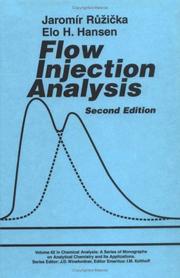
ISBN: 0471813559 Year: 1988 Volume: 62 Publisher: New York Toronto Singapore Wiley
Abstract | Keywords | Export | Availability | Bookmark
 Loading...
Loading...Choose an application
- Reference Manager
- EndNote
- RefWorks (Direct export to RefWorks)
Analytical chemistry --- Analyse instrumentale --- Instrumental analysis --- Instrumentele analyse --- Flow injection analysis --- Chemistry, Analytic --- Chemistry, Physical and theoretical --- Flow injection technique --- Flow method (Analytical chemistry) --- Rapid flow technique --- Stopped flow technique
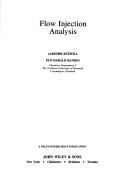
Abstract | Keywords | Export | Availability | Bookmark
 Loading...
Loading...Choose an application
- Reference Manager
- EndNote
- RefWorks (Direct export to RefWorks)
Analytical chemistry --- Technique analytique --- Analytical methods --- Chimie analytique --- Chromatographie --- Chromatography --- analytische chemie --- injection --- Flow injection analysis --- Instrumental analysis --- Chemistry, Analytic --- Chemistry, Physical and theoretical --- Flow injection technique --- Flow method (Analytical chemistry) --- Rapid flow technique --- Stopped flow technique --- Monograph --- Fia
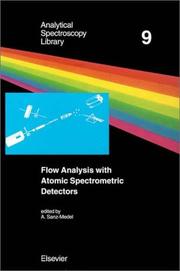
ISBN: 0444823913 9780444823915 9780080531700 0080531709 9786611047528 128104752X Year: 1999 Publisher: Amsterdam ; New York : Elsevier Science,
Abstract | Keywords | Export | Availability | Bookmark
 Loading...
Loading...Choose an application
- Reference Manager
- EndNote
- RefWorks (Direct export to RefWorks)
Flow Analysis (FA) offers a very convenient and fast approach to enhance and automate 'preliminary steps' of analysis (sample dissolution, pretreatments, preconcentrations, etc.) for atomic spectrometric detectors (ASD). Moreover, flow manifolds can ease the well-known problem of sample introduction/presentation to atomisers or even expand the classical scope of atomic/elemental information, characterizing atomic spectrometry, into the realm of molecules and metal-compounds analysis (e.g. by resorting to coupled separation techniques). All these facts could explain both the extraordinary inter
Spectrometric and optical chemical analysis --- fysicochemie --- Atomic spectroscopy. --- Flow injection analysis. --- Flow injection technique --- Flow method (Analytical chemistry) --- Rapid flow technique --- Stopped flow technique --- Instrumental analysis --- Spectroscopy, Atomic --- Spectrum analysis
Book
ISBN: 1283394073 9786613394071 0123859255 0123859247 9780123859242 9781283394079 9780123859259 Year: 2012 Publisher: Amsterdam ; Boston : Elsevier,
Abstract | Keywords | Export | Availability | Bookmark
 Loading...
Loading...Choose an application
- Reference Manager
- EndNote
- RefWorks (Direct export to RefWorks)
"Flow analysis techniques date to over eighty years ago, but modern analytical flow techniques began in the 1950s with the introduction of segmented flow analysis, followed some two decades later by flow injection analysis. Numerous books have been written over the years on flow analysis in general and flow injection analysis in particular. The most widely used detection systems employ flow cells utilising attenuation or radiation of light. This is the first book to focus on these important detection systems and methods, i.e., spectrophotometry, turbidimetry and nephelometry, and techniques based on fluorescence, chemiluminescence, and bioluminescence. It is intended to be complementary to existing monographs"--
Instrumental analysis. --- Flow injection analysis. --- Spectrophotometry. --- Luminescence spectroscopy. --- Luminescence spectrometry --- Spectrometry, Luminescence --- Spectroscopy, Luminescence --- Spectrum analysis --- Luminescent probes --- Analytical chemistry --- Astronomical photometry --- Flow injection technique --- Flow method (Analytical chemistry) --- Rapid flow technique --- Stopped flow technique --- Instrumental analysis --- Chemistry, Physical and theoretical
Book
ISBN: 1608765660 9781608765669 9781607415060 1607415062 Year: 2009 Publisher: New York Nova Science Publishers
Abstract | Keywords | Export | Availability | Bookmark
 Loading...
Loading...Choose an application
- Reference Manager
- EndNote
- RefWorks (Direct export to RefWorks)
Chemical oceanography. --- Flow injection analysis. --- Marine sediments. --- Bottom deposits (Oceanography) --- Bottom sediments (Oceanography) --- Deep-sea deposits --- Deposits, Deep-sea --- Marine deposits --- Sediments, Marine --- Ocean bottom --- Sedimentation and deposition --- Submarine geology --- Sediments (Geology) --- Flow injection technique --- Flow method (Analytical chemistry) --- Rapid flow technique --- Stopped flow technique --- Instrumental analysis --- Marine chemistry --- Oceanography --- Water chemistry
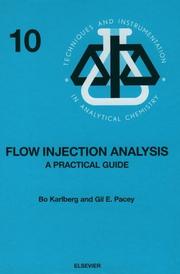
ISBN: 0444880143 9780444880147 9780080875583 0080875580 1281788589 9781281788580 9786611788582 6611788581 0444417443 9780444417442 0444425349 9786611778620 1281778621 0080875556 9780444425348 9780080875552 Year: 1989 Volume: 7 Publisher: Amsterdam ; New York : Elsevier,
Abstract | Keywords | Export | Availability | Bookmark
 Loading...
Loading...Choose an application
- Reference Manager
- EndNote
- RefWorks (Direct export to RefWorks)
This is a practical guide for first-time and experienced users of Flow Injection Analysis (FIA). It gives, not a detailed theoretical analysis, but a ``nuts and bolts'' approach to the description of the technique and how it can be utilized to solve analytical chemical problems.The advantages of flow injection, how, when, why and where it works are all fully explained. Criteria for the choice of hardware and useful hints for maintenance are provided. The large variety of detectors suitable to combine with FIA are discussed, as are special modes of operation, their advantages and their
Analytical chemistry --- Electrochemical analysis --- 543.25 --- 543.25 Electroanalysis. Electrolytic methods. Electrometric methods --- Electroanalysis. Electrolytic methods. Electrometric methods --- Analysis, Electrochemical --- Analysis, Electrolytic --- Electroanalysis --- Electrolytic analysis --- Electrochemistry --- Quantitative --- Analyse électrochimique --- Electrochemical analysis. --- Instrumental analysis. --- Flow injection analysis. --- Flow injection technique --- Flow method (Analytical chemistry) --- Rapid flow technique --- Stopped flow technique --- Instrumental analysis --- Chemistry, Physical and theoretical --- Analytical methods --- Automation --- ELECTROCHEMISTRY
Book
ISBN: 3039213164 3039213156 9783039213160 Year: 2019 Publisher: Basel, Switzerland : MDPI,
Abstract | Keywords | Export | Availability | Bookmark
 Loading...
Loading...Choose an application
- Reference Manager
- EndNote
- RefWorks (Direct export to RefWorks)
For the past 40 years, metal-based drugs have been widely used for the treatment of cancer. Cisplatin and follow-up drugs carboplatin (ParaplatinTM) and oxaliplatin (EloxatinTM) have been the gold standard for metallodrugs in clinical settings as antineoplastic agents. While effective, these drugs (either alone or in combination therapy) have faced a number of clinical challenges resulting from their limited spectrum of activity, high toxicity leading to significant side effects, resistance, poor water solubility, low bioavailability and short circulating time. In the past 10 years, various unconventional non-platinum metal-based agents have emerged as a potential alternative for cancer treatment. These compounds are highly effective and selective in cancers resistant to cisplatin and other chemotherapeutic agents. Research in this area has recently exploded with a relevant number of patents and clinical trials, in addition to reports in scientific journals. Furthermore, in parallel to the synthesis of coordination and organometallic compounds comprising many different metals and unconventional platinum-based derivatives, researchers are focused on optimizing mechanistic and pharmacological features of promising drug candidates. This Special Issue aims to highlight the latest advances in anticancer metallodrugs with a focus on unconventional anticancer agents, as well as novel activation, targeting and delivery strategies aimed at improving their pharmacological profile.
?–? stacking --- encapsulation --- n/a --- oxindolimine–metal complexes --- cyclodextrin --- platinum iodido complexes --- distribution coefficient --- antiproliferative activity --- anticancer agents --- nanotubes --- ruthenium --- platinum --- Log kw --- nanoparticles --- drug discovery --- metal complex --- metallodrugs --- isatin-derived ligands --- anticancer drug --- upconverting nanoparticles --- pyridine benzimidazole --- dendrimers --- liposomes --- thiophene --- angiogenesis --- micelles --- HSA oxidation --- platinum(IV) --- imaging --- chromatographic lipophilicity parameter --- amidophosphine --- copper and iron chelators in cancer --- Log P --- biomacromolecules --- bones --- DNA cleavage --- stopped-flow spectroscopy --- silver --- phosphonates --- transmetalation --- metallomics --- MRI --- fluorescence quenching --- partition coefficient --- gold fingers --- anticancer --- HSA binding --- gold --- ?0 --- targeting --- metastasis --- DNA interaction --- antimigration --- cytotoxicity --- HPLC --- ruthenium complexes --- zinc finger proteins --- Gold(III) complexes --- aquaporins --- antiproliferative --- protein-DNA recognition --- photoactivation --- lipophilicity --- cancer --- 1-methylcytosine --- PET --- ?-? stacking --- oxindolimine-metal complexes
Book
Year: 2021 Publisher: Basel, Switzerland MDPI - Multidisciplinary Digital Publishing Institute
Abstract | Keywords | Export | Availability | Bookmark
 Loading...
Loading...Choose an application
- Reference Manager
- EndNote
- RefWorks (Direct export to RefWorks)
This book covers the most recent research trends and applications of Pharmaceutical Analytical Chemistry. The included topics range from the adulteration of dietary supplements, to the determination of drugs in biological samples with the aim to investigate their pharmacokinetic properties.
growth hormone --- long-acting Fc-fusion recombinant human growth hormone --- method validation --- cell-based bioassay --- reporter gene assay --- pharmacokinetics --- tissue distribution --- alnustone --- rats --- LC-MS/MS --- inflammatory bowel disease --- fixed-dose combination --- biomimetic chromatography --- thiopurine immunosuppressants --- folic acid --- doxorubicin --- hernandezine --- pharmacokinetic study --- drug–drug interaction --- gardneramine --- monoterpenoid indole alkaloid --- memantine --- rimantadine --- amantadine --- zone fluidics --- o-phthalaldehyde --- derivatization --- stopped-flow --- quality control --- anwuligan --- rat --- optode --- polyhexamethylene biguanide hydrochloride --- lactone-rhodamine B --- contact-lens detergent --- dietary supplement --- adulteration --- low-field NMR --- multivariate analysis --- steroids --- Partial Least Squares regression --- in vitro permeability --- predictive model --- ketamine --- norketamine --- high throughput bar adsorptive microextraction --- LVI-GC-MS(SIM) --- urine --- baricitinib --- UPLC-MS/MS --- irbersartan --- n/a --- drug-drug interaction
Book
Year: 2021 Publisher: Basel, Switzerland MDPI - Multidisciplinary Digital Publishing Institute
Abstract | Keywords | Export | Availability | Bookmark
 Loading...
Loading...Choose an application
- Reference Manager
- EndNote
- RefWorks (Direct export to RefWorks)
This book covers the most recent research trends and applications of Pharmaceutical Analytical Chemistry. The included topics range from the adulteration of dietary supplements, to the determination of drugs in biological samples with the aim to investigate their pharmacokinetic properties.
Research & information: general --- growth hormone --- long-acting Fc-fusion recombinant human growth hormone --- method validation --- cell-based bioassay --- reporter gene assay --- pharmacokinetics --- tissue distribution --- alnustone --- rats --- LC-MS/MS --- inflammatory bowel disease --- fixed-dose combination --- biomimetic chromatography --- thiopurine immunosuppressants --- folic acid --- doxorubicin --- hernandezine --- pharmacokinetic study --- drug-drug interaction --- gardneramine --- monoterpenoid indole alkaloid --- memantine --- rimantadine --- amantadine --- zone fluidics --- o-phthalaldehyde --- derivatization --- stopped-flow --- quality control --- anwuligan --- rat --- optode --- polyhexamethylene biguanide hydrochloride --- lactone-rhodamine B --- contact-lens detergent --- dietary supplement --- adulteration --- low-field NMR --- multivariate analysis --- steroids --- Partial Least Squares regression --- in vitro permeability --- predictive model --- ketamine --- norketamine --- high throughput bar adsorptive microextraction --- LVI-GC-MS(SIM) --- urine --- baricitinib --- UPLC-MS/MS --- irbersartan
| Listing 1 - 10 of 17 | << page >> |
Sort by
|

 Search
Search Feedback
Feedback About UniCat
About UniCat  Help
Help News
News